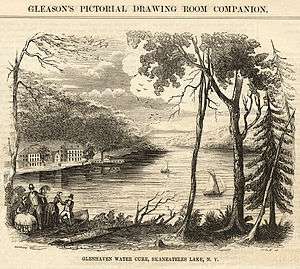William L. Chaplin
| William Lawrence Chaplin | |
|---|---|
 William Lawrence Chaplin, c. 1851 | |
| Born |
October 27, 1796 Groton, Massachusetts |
| Died |
April 28, 1871 (aged 74) Cortland, New York |
| Nationality |
|
| Occupation | abolitionist |
| Known for | Liberty Party (United States, 1840) candidate for lieutenant governor of New York, 1846, and governor of New York, 1850; helped organize and finance attempted escape of 77 slaves from Washington, D.C., in the Pearl incident, 1848; arrested in 1850 and briefly jailed for assisting attempted escape of two fugitive slaves from Washington.[1] |
| Spouse(s) | Theodosia Gilbert Chaplin (1819–1855) [2] |
| Children |
Harriet L. "Hattie" Chaplin (1852–1861) [3] Theodosia Chaplin Walton (1855–1905) [4][5] |
| Parent(s) |
Rev. Daniel Chaplin (1744–1831) Susanna Prescott Chaplin (1757–1832) [6] |
William Lawrence Chaplin (October 27, 1796 – April 28, 1871) was a prominent abolitionist in the years before the American Civil War. Known by the title of "General," he was an agent for the New York Anti-Slavery Society.[7]
In 1850 in Washington, DC, Chaplin aided two of the slaves of then congressman Robert Toombs in an attempted escape. The slaves were Lousia and, possibly, Garland H. White.[8] During the pursuit of the escapees, Toombs said that he was more concerned about Lousia than White, as he did not care for White. Both were caught when a posse of six slave catchers chased Chaplin's carriage out of Washington. During the chase, the posse shot into the carriage, wounding the occupants. When they were caught, Chaplin was beaten and held in D.C. for six weeks. Chaplin was bailed by prominent abolitionist Gerrit Smith and others. The money was forfeited, as Chaplin skipped bail and returned to New York.[9]


Notes and references
- ↑ National Historical Marker Database. "William L. Chaplin Arrested!". hmdb.org. Retrieved January 3, 2015.
- ↑ Ancestry.com. New York Marriage Notices, 1800-55 (database on-line). Provo, UT, USA: Ancestry.com Operations Inc, 2000. Original data: Early Marriages From Newspapers Published in Central New York. n.p.: Pipe Creek Publications, 1992.
- ↑ Ancestry.com. New York, State Census, 1855 (database on-line). Provo, UT, USA: Ancestry.com Operations, Inc., 2013. Original data: Census of the state of New York, for 1855. Microfilm. New York State Archives, Albany, New York.
- ↑ Ancestry.com. Cook County, Illinois, Marriages Index, 1871–1920 (database on-line). Provo, UT, USA: Ancestry.com Operations, Inc., 2011. Original data: “Illinois, Cook County Marriages, 1871–1920.” Index. FamilySearch, Salt Lake City, Utah, 2010. Illinois Department of Public Health records. "Marriage Records, 1871–present." Division of Vital Records, Springfield, Illinois.
- ↑ Ancestry.com. Philadelphia, Pennsylvania, Death Certificates Index, 1803–1915 (database on-line). Provo, UT, USA: Ancestry.com Operations, Inc., 2011. Original data: "Pennsylvania, Philadelphia City Death Certificates, 1803–1915." Index. FamilySearch, Salt Lake City, Utah, 2008, 2010. From originals housed at the Philadelphia City Archives. "Death Records."
- ↑ Ancestry.com. Massachusetts, Town and Vital Records, 1620–1988 (database on-line). Provo, UT, USA: Ancestry.com Operations, Inc., 2011. Original data: Town and City Clerks of Massachusetts. Massachusetts Vital and Town Records. Provo, UT: Holbrook Research Institute (Jay and Delene Holbrook).
- ↑ Long Island Genealogy. "New Yorkers Active in the Underground Railroad". longislandgenealogy.com. Retrieved January 3, 2015.
- ↑ Miller Jr, Edward A. "Garland H. White, black army chaplain." Civil War History 43.3 (1997): 201-218 suggests only Louisa was involved and not White
- ↑ Scroggins, Mark. Robert Toombs: The Civil Wars of a United States Senator and Confederate General. McFarland, 19 Jul 2011, p66-67
- ↑ Lowry, Bates; Lowry, Isabel (2000). The Silver Canvas: Daguerreotype Masterpieces from the J. Paul Getty Museum. Getty Publications. p. 180. ISBN 0892365366. Retrieved January 6, 2015.
- ↑ Harrold, Stanley (2003). Subversives:Antislavery Community in Washington, D.C., 1828-1865. Baton Rouge: Louisiana State University Press. p. 161. ISBN 0-8071-2805-8.
External links
- "William L. Chaplin". Find a Grave. Retrieved January 3, 2015.
- "Theodosia Gilbert Chaplin". Find a Grave Retrieved January 6, 2015.